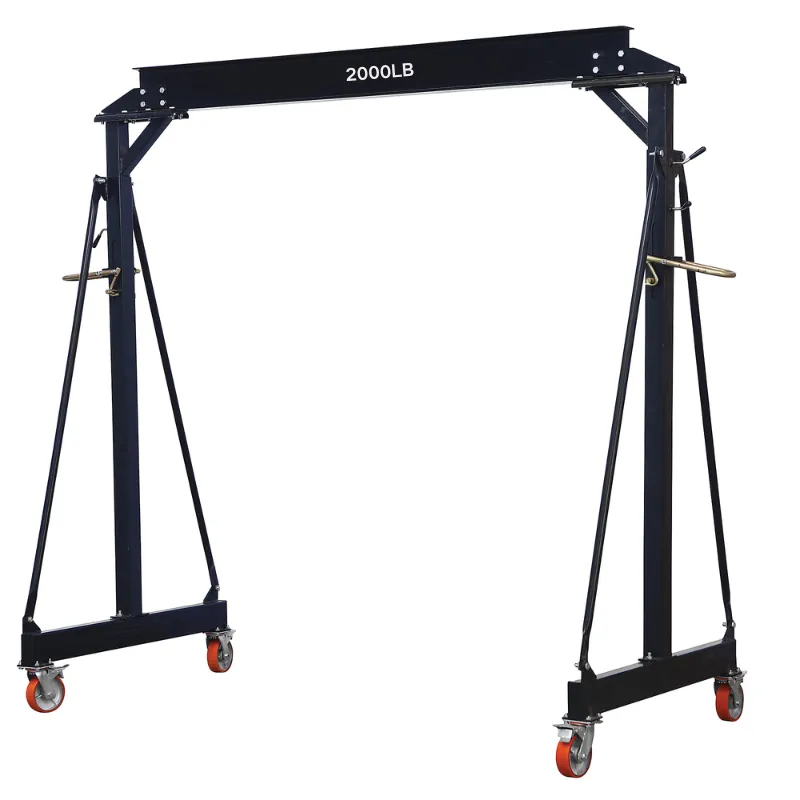rigging gantry
The Importance of Rigging Gantries in Modern Industry
In the ever-evolving landscape of modern industrial engineering, the demand for efficient and effective material handling solutions has surged. One such innovative solution is the rigging gantry, a critical piece of equipment that significantly enhances lifting capabilities across various sectors. This article will explore the features, advantages, applications, and safety considerations associated with rigging gantries.
Understanding Rigging Gantries
A rigging gantry, often referred to as a gantry crane, is a type of crane that consists of a girder supported by two or more legs, which can move along a set of tracks. This design allows it to lift and transport materials and equipment over short distances. Rigging gantries are widely used in construction sites, warehouses, shipping yards, and manufacturing plants for various tasks, including lifting heavy loads, positioning equipment, and facilitating the assembly of large structures.
Features of Rigging Gantries
Rigging gantries come equipped with numerous features that enhance their operability and efficiency. Typically made of robust materials such as steel or aluminum, they are constructed to withstand significant loads while remaining lightweight and portable. Many of these gantries feature
1. Adjustable Height The ability to adjust the height of the gantry allows operators to customize it according to the specific needs of the job, making it versatile for multiple applications.
2. Mobility Equipped with wheels, rigging gantries can easily move from one location to another within a worksite. This mobility is crucial in environments where space is limited.
3. Capacity Depending on the model, rigging gantries can handle loads ranging from a few hundred pounds to several tons, making them suitable for various materials and equipment.
4. Lifting Mechanism Many gantries are fitted with electric or manual hoists that enable smooth and controlled lifting operations, reducing the risk of accidents and making the lifting process more efficient.
Advantages of Using Rigging Gantries
The advantages of rigging gantries extend across several dimensions
1. Increased Efficiency By streamlining the lifting process, gantries reduce the time and labor required to move heavy items, thereby enhancing overall productivity.
rigging gantry

2. Space-Saving Design Their compact design allows gantries to operate effectively in confined spaces, allowing for better utilization of floor areas in warehouses and factories.
3. Cost-Effectiveness Investing in a rigging gantry can be more economical than permanent overhead lifting systems, particularly for smaller operations or temporary projects.
4. Flexibility The ability to adjust height and mobility means that rigging gantries can be used across a variety of tasks and settings, making them highly adaptable to changing project requirements.
Applications of Rigging Gantries
Rigging gantries find application in numerous industries, including
- Construction Used to lift heavy materials such as steel beams, concrete slabs, and equipment, aiding in the speedy assembly of structures.
- Manufacturing Employed on assembly lines to position components and machinery, contributing to the efficiency of production processes.
- Shipping and Logistics Facilitating the loading and unloading of cargo containers, improving the flow of goods in shipping yards.
- Maintenance and Repair Used for lifting engines, heavy machinery, or infrastructure components during repair and maintenance operations.
Safety Considerations
While rigging gantries provide numerous benefits, safety should always be a top priority. Operators must receive proper training to understand the equipment's capabilities and limitations. Regular inspections and maintenance are essential to ensure the gantry remains in safe working condition. Additionally, load limits should never be exceeded, and appropriate rigging techniques must be employed to prevent accidents and injuries.
Conclusion
In conclusion, rigging gantries are indispensable tools in modern industrial operations. Their flexibility, efficiency, and adaptability make them ideal for a wide range of applications. As industries continue to seek innovative solutions to enhance productivity and safety, rigging gantries will undoubtedly play a vital role in shaping the future of material handling and logistics. Embracing this technology can lead to significant improvements in operational effectiveness, ultimately contributing to the success and sustainability of businesses in various sectors.
-
Unlock Seamless Relocation with Our Heavy Equipment Moving ExpertiseNewsJun.06,2025
-
Unleash Unrivaled Flexibility with Our Adjustable Gantry CraneNewsJun.06,2025
-
Unleash Heavy-Duty Efficiency with Our Industrial Gantry Crane SolutionsNewsJun.06,2025
-
Revolutionize Steel Handling with Our Magnetic Lifter RangeNewsJun.06,2025
-
Master Equipment Mobility with Premium Machinery Mover SolutionsNewsJun.06,2025
-
Elevate Your Material Handling with Magnetic Lifter TechnologyNewsJun.06,2025
-
YS Permanent Lifting Magnets: The Smarter Way to Handle SteelNewsMay.22,2025
